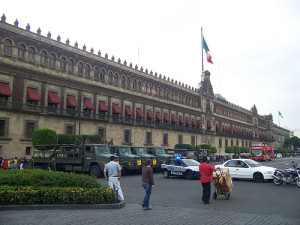A More Ambitious Vision for Mexico

 By Antonio Garza, U.S. Ambassador (Ret.)
By Antonio Garza, U.S. Ambassador (Ret.)
Mexico’s economic resurgence is gaining widespread attention. Optimism about the country’s prospects is on the upswing, as evidenced by the term “Aztec Tiger,” a clever coinage by theFinancial Times. It’s a welcome change in focus and tone. And by adding dimension to the country’s story, without diminishing the security challenges Mexico faces, it allows a more balanced and accurate portrayal to emerge.
President Enrique Peña Nieto has been in office just 3 months, yet there’s a sense of urgency attached to his ambitious agenda. Substantial challenges loom and surmounting them will require the president’s and the administration’s full complement of skills: from political deal making and legislative maneuvering to strategic communications and diplomacy
There’s some trepidation on the domestic front given the scope of change and the sectors it will touch, but there’s also optimism. I see five reasons Mexico should be able to maintain its new momentum and also transition to a higher-profile global leadership role.
An Open Economy
Mexico’s economy ranks among the world’s most open and competitive. Since opening its economy in the mid-1990s, Mexico’s trade with the world has risen rapidly: registering a 475% increase in exports between 1994 and 2011 and a 342% increase in imports.
Trade makes up a bigger portion of Mexico’s GDP (63%) than of any other large country’s, including the US and China. Annual exports of manufactured goods are roughly equal to the value of all exports by the rest of Latin America.
Mexico currently boasts 12 FTAs that provide preferential access to 44 countries (more than any other country). It was the first Latin American country to gain preferential access to the European Union (2000). Its agreement with Japan (2005) was the first comprehensive trade pact that country had signed with any nation.
And Mexico continues to lead. Last year, it joined negotiations for the proposed Trans-Pacific Partnership (TPP), the multilateral FTA that the US considers central to its “Asia Pivot.” Mexico views the TPP as an opportunity to be part of the first 21st century FTA, implying both an opportunity to “update” NAFTA and to build out a more strategic approach to hemispheric trade relations.
Mexico has developed its stature on the international stage largely through trade. In contrast to other countries in Latin America, Mexico’s pursuit of trade alliances hasn’t been driven by ideological concerns but by a pragmatic focus on economic policy and strategic geopolitical interests.
With NAFTA, Mexico became a pioneer among emerging markets of economic integration and trade liberalization. The agreement provided an institutional framework-in essence a “rule of law” governing trading practices-on which the country has built a global presence while developing closer connections with the world’s largest and most dynamic economy.
NAFTA also facilitated meaningful change in Mexican society. The country is now majority middle class: 17 percent of Mexicans joined the middle class from 2000 to 2010 according to the World Bank. This new middle class is younger, more educated, wealthier and healthier and far more likely to protect their economic gains and hold their government accountable.
Today, as Europe and Asia look to build stronger ties to Latin America, Mexico is of priority interest because of its core values and its strong record of promoting trade and investment along with growth and effective institutions.
Solid Economic Fundamentals
Mexico’s economic transformation under NAFTA has been profound. Few countries have an economic record as impressive as Mexico’s: more than 17 years of macroeconomic stability, low inflation and interest rates, manageable debt, record high international reserves, economic openness and increasing competitiveness.
Though Mexico suffered a brutal recession during the global financial crisis, it has clawed its way back. GDP growth has been in the 4 percent range for three years running, making the country a top performer regionally. And Mexico has supplanted Brazil as the main focus for economic optimism in the region: over the first nine months of 2012, its stock market received five times as much investment as Brazil’s.
Pragmatic Leadership
The global economic turmoil of recent years has made this much clear: arguably the most important determinant of economic success is leaders who understand and can implement the reforms required for growth. It’s far too early in the Peña Nieto administration to declare success, but the president and his team have been highly effective thus far.
Labor, accounting and education reform measures passed during the transition were substantive accomplishments and signaled a break from years of inaction and gridlock. The Pacto por México, announced in hours of the inauguration, saw the three main political parties presenting a unified front for the first time in decades.
Fiscal and energy reform are top priorities, as both are essential if the country is to accelerate growth and improve its competitiveness. The mere fact that a PRI government is willing to tackle both underscores the generational shift within the party and growing acceptance of the need for change in how the country manages its economic affairs.
A favorable convergence of issues
A short list of the issues and developments that appear to be trending positively includes: a recovering US economy; growing global demand for US and Mexican manufactures; a likely reform of US immigration policies; the rising costs of doing business in China and transatlantic interest in deepening trade and investment ties with Latin America.
A more ambitious Vision for Mexico
Mexico faces brighter prospects than it has in decades. But to fully realize the promise of what the president has termed “Mexico’s moment,” the administration must do more than ensure progress on the economic front. It must also modernize institutions, strengthen its commitment to good governance, assert the rule of law, support human rights, lead on the environment and promote greater inclusiveness.
Mexico has set its sights high. By aiming even higher, it just might find itself not only growing, but leading in Latin America and transitioning into a real leadership role in the world.
This article was first published in tonygarza.com.
Antonio Garza served as U.S. Ambassador to Mexico from 2002-2009. Mr. Garza is now counsel in the Mexico City office of White & Case and Chairman of Vianovo Ventures, the cross-border business development unit of Vianovo, LP.
[Photos by davdibiase, Jami Dwyer]

